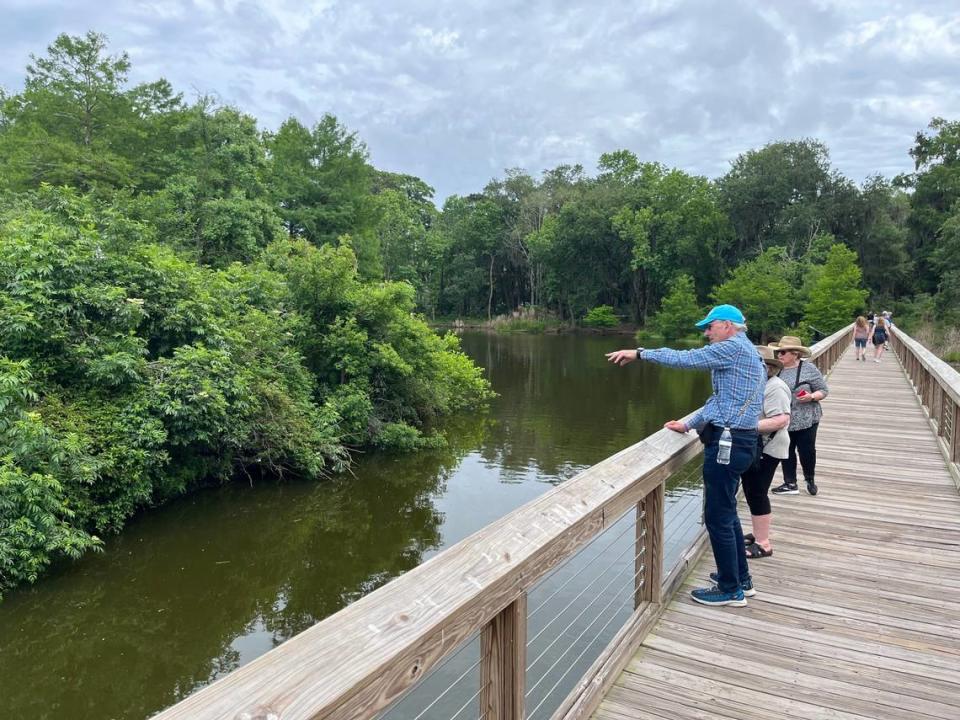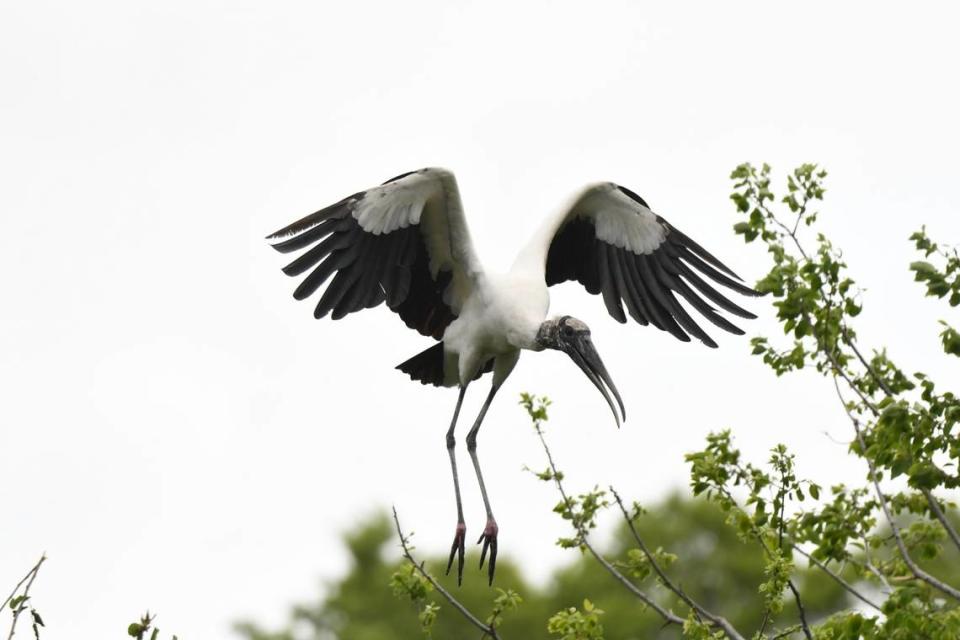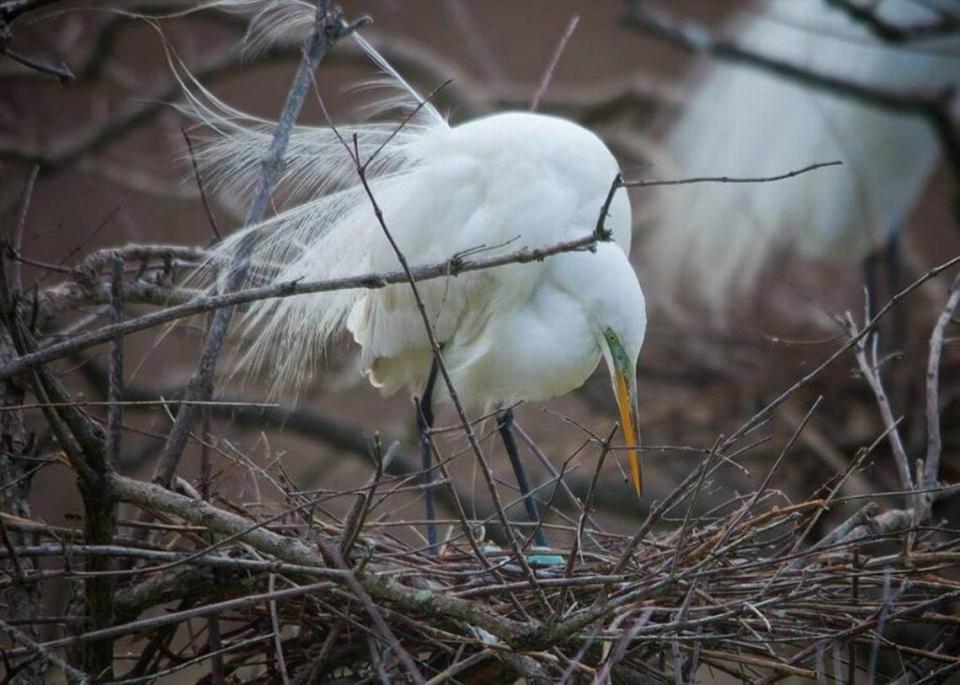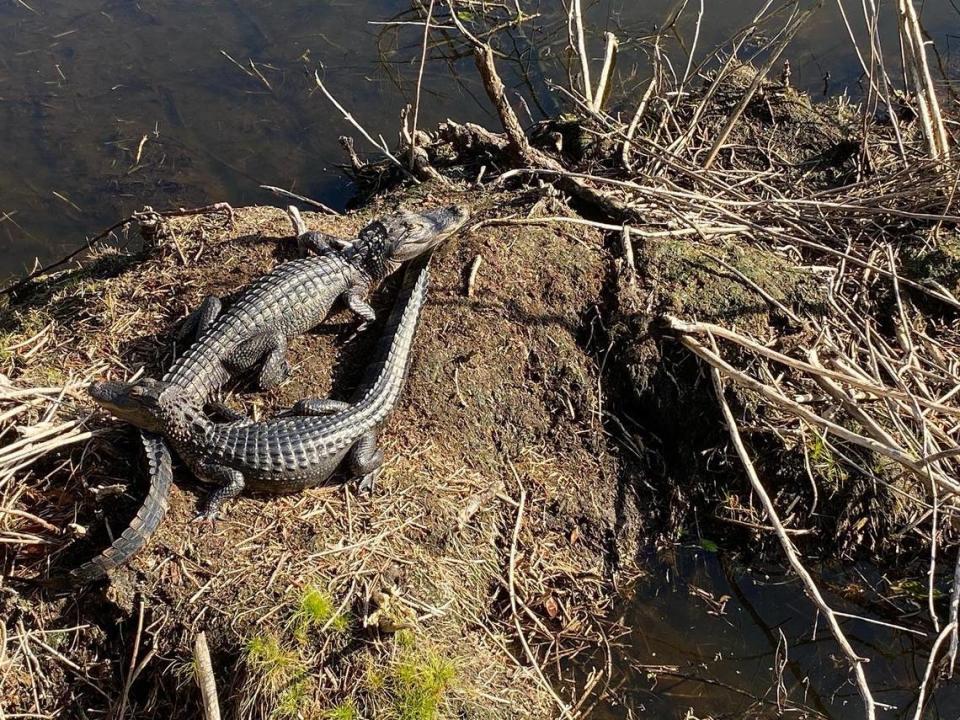‘This is breathtaking.’ Here’s why birds (and visitors) love Port Royal’s downtown rookery
Squeaks and squawks and gurgles came from big white birds in the thick green vegetation, occasionally taking flight and cruising across the still waters of Cypress Wetlands, looking down on alligators and turtles and tourists like Brian Glass of Virginia.
“This is breathtaking,” says Glass, standing on a boardwalk, where he had a front-row seat for the sights and sounds of the Cypress Wetlands and Rookery in Port Royal.
Each year, thousands of herons and egrets and other species of all stripes choose to gather at this relatively tiny wild oasis in the heart of the town of 14,000 — and the spectacle is a big draw for visitors from across South Carolina and even beyond.
And with chicks beginning to hatch, traffic is picking up.
“If you looked at the trees, if you were standing there at night, it would look like snow,” says Jenn Clementoni, the owner of Birding Beaufort and a Lowcountry master naturalist, referring to the predominate color seen in the bird bonanza.
A unique water management system that uses a series of wetlands to control stormwater runoff, completed in the late 2000s, restored the historic rookery but nobody was expecting the overwhelming numbers that have made Cypress Wetlands into what Clementoni says is the most important rookery in the Lowcountry. It’s even recognized as one of the best statewide, she says.

Clementoni knows birders and photographers who travel to Cypress Wetlands from all over South Carolina and even Georgia, especially at this time of year, when birds are building nests and chicks are emerging. The location will be a hot-spot for bird activity for the next six weeks.
From a boardwalk, visitors can watch great egret, snowy egret, tri-color heron, little blue heron, black-crowned night herons, green herons and white ibis hunting for crabs and toads in the shallow waters and roosting and nesting in the trees — not to mention alligators and other swamp creatures.
“It’s unbelievable,” Clementoni says.
During the day, up to 200 birds can be seen but come sundown, at roosting time, the number swells to more than 1,000. It’s not necessarily the large number of birds or the size of the rookery that stands out, Clementoni says, but rather the diversity of bird species attracted to such a small area.
Even though Cypress Wetlands is easily accessible, birds nest on islands making them protected from predators and people, Clementoni says. The wetlands also have several tree species, such as cypress, maple and pines, making it attractive to all kinds of birds, Clementoni adds. Those are two of the factors that make Cypress Wetlands so attractive to so many species, Clementoni says.
And some species — including wood storks — have begun showing up in larger numbers in recent years. Driven out of Florida and elsewhere by storms and habitat loss, the birds are searching for new territory. The migration of these species, says Clementoni, highlights the critical role Cypress plays in bird conservation.

“It’s a jewel for the whole town of Port Royal,” says Scot Clark, president of Friends of Port Royal, a not-for-profit that formed in 2019 to promote the wetlands.
On a recent walk, Clark not only saw the wood storks, which has birders abuzz, but also 13 alligators.
Since late January, when Friends of Cypress Wetlands installed sensor motion counters, an average of 371 people have walked the main boardwalk daily, with the weekend number spiking as high as 671.
Even Clark, who walks the wetland boardwalk daily, was surprised by the numbers.
The weekend rise in visitors, Clark suspects, is at least partly due to families who are in the area for graduations at nearby Marine Corps Recruit Depot Parris Island. The numbers, Clark adds, will surely increase as the weather improves.
By comparison, Sands Beach, the town’s top draw, is attracting 559 cars or golf carts daily, according to another traffic counter the not-for-profit installed at the popular beach in February.

On Thursday, Glass, the Virginia man, and his wife, Ellen, and her sister, Barbara Kopel of New Jersey, were among the visitors at the wetlands. Some nibbled on ice cream cones or pushed babies in strollers on the boardwalk. Some carried cameras with lenses the size of bazookas around their necks. All just feet away from alligators and turtles sunning themselves in the mud and birds perched on trees or hiding in the bushes.
“You are so up front and personal with the birds,” Ellen Glass said of the appeal of the experience.
They could not say enough about boardwalk, which gives visitors the great access. The trio watched a mama feeding a chick.
What visitors to the watery wonderland might not know is Cypress is more than a rookery: It also handles millions of gallons of stormwater runoff so the town doesn’t swamp during heavy rains and hurricanes.
The stormwater collection system mimics how water naturally collects in wetlands and drains into streams and rivers — before development and homes choked the flow. Five wetlands are connected by pipes and ditches that ultimately deposit the town’s runoff into the Beaufort River.
“In my opinion, it should be a showcase of how stormwater management should be done,” says Van Willis, Port Royal’s town manager.
The main wetland, Willis said, had become isolated and had no outfalls, leaving no place for the water to go, causing flooding. An old photo, which showed the location of the historic wetlands system, helped Port Royal recreate what nature originally intended. Today, it can catch up to 15 million gallons of water and diverts it through a series of wetlands and into the Beaufort River.
Port Royal, Willis said, was one of the first communities to embrace that type of system, which also controls water level so too much doesn’t harm cypress trees while keeping levels high enough to prevent predators such as raccoon from reaching nesting birds.
In effect, Willis says of Cyrpess Wetlands, the town is getting a twofer: a stormwater management system and an escape for residents and visitors that feels remote even though it’s downtown and close to Ribaut Road and Paris Avenue.

Planning began in 1999 and the town has invested more $1 million. The number of birds that showed up, Willis said, was surprising.
“We knew it had some redeeming value as a rookery,” Willis said, “but just the diversity of species and sheer numbers was a bit overwhelming.”
On Saturday, up to 200 kids were scheduled to gather at the wetlands for an annual event called Birthday for the Birds. Pete Richards, an early promoter of the rookery who died in 2020, started the event in 2012 as away to raise awareness about its importance. At a time when birds are hatching, the kids sing happy birthday, with kazoos as an accompaniment.
“It just has blown our minds the number of people that come and visit the wetlands now,” says Kat Bray, a Friends of Cypress Wetlands board member. “Pretty special.”
If you go
Birthday for the Birds is 9-11 a.m. Saturday at Cypress Wetlands and Rookery on Paris Avenue in Port Royal. It includes a scavenger hunt and, at 10:30 p.m. a birthday song with kazoos. Port Royal Foundation and Jill Moore, a master naturalist, will have critters on hand including turtles and snakes.

